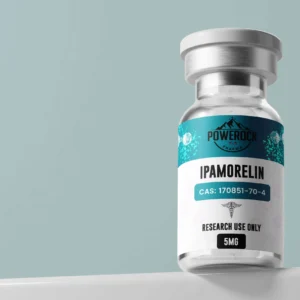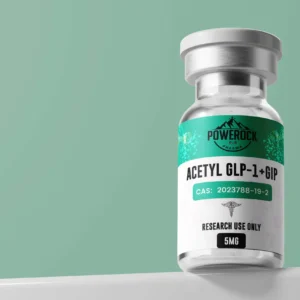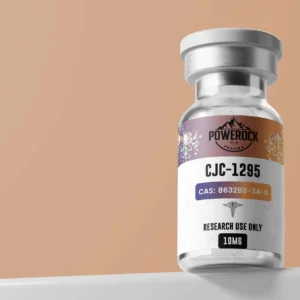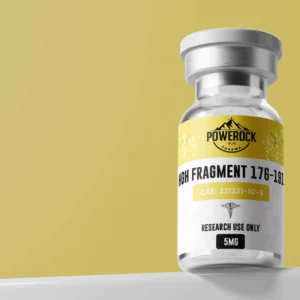Properties:
Kisspeptin-10, also known as Metastin (45-54), is a potent peptide widely recognized for its significant impact on reproductive health and hormonal regulation. It plays a crucial role in stimulating the release of gonadotropin-releasing hormone (GnRH), which in turn triggers the production of essential reproductive hormones like luteinizing hormone (LH) and follicle-stimulating hormone (FSH). This peptide has garnered attention for its potential applications in fertility research, making it a preferred choice for those studying reproductive endocrinology and related fields.
Mechanism of action:
The action of Kisspeptin-10 revolves around its ability to bind to the GPR54 receptor (Kiss1R), which is predominantly expressed in the hypothalamus. Upon binding, Kisspeptin-10 activates signaling pathways that lead to the secretion of GnRH from the hypothalamic neurons. This secretion of GnRH is pivotal in regulating the release of LH and FSH from the pituitary gland, which are critical hormones in the reproductive process. This mechanism underpins its potential applications in enhancing fertility, regulating menstrual cycles, and studying the onset of puberty. Kisspeptin-10’s selective action on the reproductive axis ensures that it targets the desired physiological outcomes without significantly affecting other hormonal pathways, making it a focused tool for research in hormonal modulation.
Benefits:
Research involving consistent use of Kisspeptin-10 has shown potential benefits in various aspects of reproductive health. Studies suggest it may improve fertility by enhancing the release of reproductive hormones, which could be particularly beneficial in cases of hormone deficiency or reproductive disorders. Additionally, Kisspeptin-10 has been explored for its role in regulating the onset of puberty and maintaining reproductive function, making it a versatile tool in both clinical and research settings. Researchers may also observe secondary benefits, such as improved hormonal balance and potential mood stabilization due to the peptide’s influence on the reproductive hormone axis. Kisspeptin-10 is particularly valuable for researchers focused on fertility, reproductive health, and hormonal therapies.
Why Powerock Pharma:
At Powerock Pharma, we are committed to delivering excellence in every batch of Kisspeptin-10. Our products are manufactured in state-of-the-art facilities that adhere to the highest quality standards, including GMP, HACCP, and ISO 13485 certifications. We partner with leading laboratories to ensure that every batch of Kisspeptin-10 is of the highest purity and potency, providing researchers with reliable and consistent results. Our rigorous quality control measures guarantee that you receive a product that is not only effective but also safe for use in advanced research. When you choose Powerock Pharma, you choose a partner dedicated to supporting your research with precision and reliability.
Summary:
If you are looking to advance your research in reproductive health and hormonal balance, Kisspeptin-10 is the ideal peptide to explore. Backed by Powerock Pharma’s rigorous quality standards, this product is designed to support your research endeavors with unmatched accuracy and effectiveness. Don’t settle for anything less—order Kisspeptin-10 today and take your research to the next level.
Chromatogram KISSPEPTIN-10

Research Method KISSPEPTIN-10
How to use KISSPEPTIN-10
How to take:
Kisspeptin-10 should be administered following the specific requirements of your research protocol. This peptide is typically reconstituted with bacteriostatic water before use. It can be administered via subcutaneous or intramuscular injection, depending on the research design. Ensure that all preparations and administrations are conducted under sterile conditions to maintain the integrity of the research.
When to take:
For optimal research outcomes, Kisspeptin-10 should be administered at consistent intervals as dictated by the research protocol. Commonly, injections are given daily or multiple times a week, depending on the specific goals of the study. Maintaining regular administration times enhances the reliability of the data collected.
Cycle length:
The recommended research cycle length for Kisspeptin-10 typically ranges from 8 to 12 weeks. This period allows sufficient time to observe the peptide’s effects on reproductive hormones and other related variables. Researchers should document changes and effects throughout the cycle to capture comprehensive data.
Dosage for women:
In research involving female subjects, a lower dosage of Kisspeptin-10 is generally recommended. A starting dose of 5mg per administration is typical, with adjustments made based on the specific research objectives and observed responses. Careful monitoring is essential to ensure the desired outcomes are achieved without adverse effects.
Dosage for men:
For male subjects, a dosage of 10mg per administration is commonly used in research settings. Depending on the study’s focus, this dosage may be adjusted to optimize the peptide’s effects. Regular monitoring and data collection are crucial to assess the impact of the dosage and make necessary modifications.
Monitoring:
Continuous monitoring of research subjects is essential when administering Kisspeptin-10. Researchers should regularly assess hormone levels, reproductive health indicators, and any side effects that may arise. Accurate data collection during the study period is critical to understanding the peptide’s full range of effects and ensuring subject safety.
How to Stack KISSPEPTIN-10
Kisspeptin-10 + Gonadorelin (GnRH analogue):
Combining Kisspeptin-10 with Gonadorelin can enhance the stimulation of GnRH release, leading to a more pronounced increase in LH and FSH levels. This stack is particularly effective in studies focusing on boosting reproductive hormone production and fertility.
Kisspeptin-10 + Human Chorionic Gonadotropin (hCG):
This combination is valuable for research aimed at supporting testosterone production and maintaining testicular function. The synergistic effects of Kisspeptin-10 and hCG may lead to improved outcomes in studies exploring male fertility and hormonal balance.
Kisspeptin-10 + Growth Hormone-Releasing Peptide (GHRP-6):
For research focused on growth hormone secretion and its effects on metabolism, stacking Kisspeptin-10 with GHRP-6 can provide insights into how reproductive hormones and growth hormones interact. This combination may be beneficial in studies related to growth, development, and metabolic health.
Kisspeptin-10 + Peptide YY (PYY):
This stack can be explored in research focusing on appetite regulation and reproductive health. Kisspeptin-10 combined with PYY might provide valuable data on how reproductive hormones influence appetite control and energy balance.
Kisspeptin-10 + Melatonin:
Pairing Kisspeptin-10 with melatonin may offer insights into the interplay between reproductive hormones and circadian rhythms. This combination is ideal for studies investigating the effects of hormonal regulation on sleep patterns and overall reproductive health.
Frequently Asked Questions About KISSPEPTIN-10
What is the recommended dosage for research purposes?+
The recommended dosage for Kisspeptin-10 in research varies based on the study design and subject demographics. Typically, 5mg per administration is used for female subjects, while 10mg is standard for male subjects. Adjustments should be made according to research needs and observed responses.
Can this product be used in combination with other compounds?+
Yes, Kisspeptin-10 can be effectively stacked with other peptides or hormones, depending on the research objectives. Common combinations include Gonadorelin, hCG, and GHRP-6, among others, to enhance reproductive hormone stimulation and study various hormonal interactions.
What are the potential side effects observed in research?+
Side effects associated with Kisspeptin-10 in research are generally minimal, but some subjects may experience mild discomfort at the injection site or changes in hormone levels. It is crucial to monitor subjects closely and adjust dosages if necessary to minimize any adverse effects.
Is this product safe for long-term research?+
Kisspeptin-10 is considered safe for use in research when administered according to established protocols. However, as with all research compounds, long-term effects should be carefully monitored, and any unexpected outcomes should be thoroughly documented.
How should this product be stored?+
Kisspeptin-10 should be stored in a cool, dry place, typically at a temperature of 2-8°C. Once reconstituted, it is advisable to use the product promptly or store it according to specific research guidelines to maintain its potency and effectiveness.
What makes Powerock Pharma products reliable for research?+
Powerock Pharma is committed to providing the highest quality research compounds. Our products undergo rigorous testing to ensure purity and potency, and our manufacturing facilities comply with the most stringent industry standards, including GMP, HACCP, and ISO 13485. This dedication to quality ensures that researchers can trust Powerock Pharma for consistent, reliable results.











